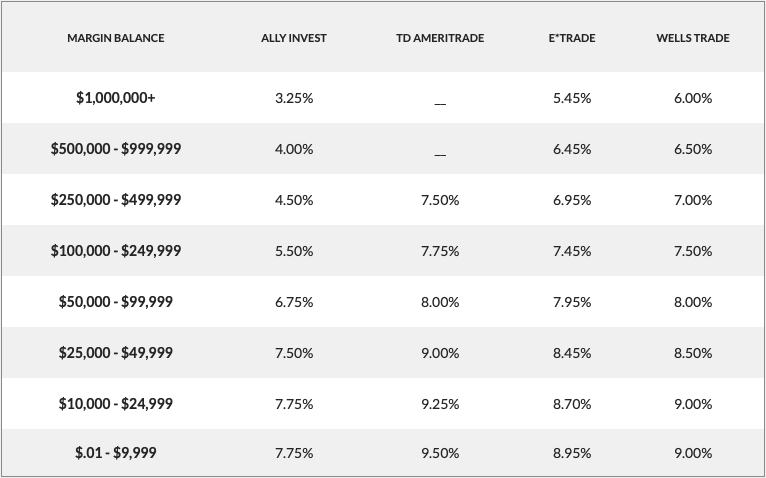Many people use home equity loans backed by their home’s value to finance renovations that improve that value. In the same way, many investors use margin loans backed by their portfolio to purchase additional securities that enhance their portfolio’s returns. While margin loans provide leverage, investors should take the time to understand how they work to avoid risks and common pitfalls.
Let’s examine how margin loans work and why you may want to consider using them in your portfolio.
What Is Margin?
Margin loans, or Reg T loans, enable investors to borrow up to 50% of the purchase price of marginable securities. So, for example, an investor with $10,000 in cash can purchase $20,000 worth of marginable stock. The investor would pay half of the purchase price, and the brokerage firm would lend the other half, providing a significant amount of leverage.
As with any loan, margin loans have an interest rate that varies based on the brokerage and loan amount. Margin interest rates are usually lower than credit cards and unsecured personal loans. Unlike conventional loans, there’s no repayment schedule. Instead, monthly interest charges accrue, and investors can repay the principal at any time.

Some brokers provide portfolio margin, which may have lower margin requirements than Reg T margin, thereby providing more leverage. Rather than borrowing up to a set level of 50%, portfolio margin considers an investor’s entire portfolio and potential losses under a set of market conditions. But, of course, more margin also translates to greater risk.
Margin Pros and Cons
The benefit of using margin is obvious: Investors can improve their returns using greater leverage. In other words, you can purchase more stock than you could with cash only and keep all of the extra profit that you generate. But, leverage also escalates portfolio losses.
Gains without Margin
| You buy 100 shares of a $10 stock | -$1,000 |
| Stock increases to $15, and you sell 100 shares | $1,500 |
| Your return | $500 (+50%) |
Gains with Margin
| You buy 100 shares of a $10 stock | -$1,000 |
| You buy another 100 shares on margin | $0 |
| Stock increases to $15, and you sell 200 shares | $3,000 |
| You repay the margin loan with interest (8%) | -$1,080 |
| Your return | $920 (+92%) |
Of course, margin is a double-edged sword capable of magnifying losses if a stock moves lower. That is, if a stock moves lower, you will lose more money than you would have lost if you had just purchased the stock with cash.
Losses without Margin
| You buy 100 shares of a $10 stock | -$1,000 |
| Stock decreases to $8, and you sell 100 shares | $800 |
| Your return | -$200 (-20%) |
Losses with Margin
| You buy 100 shares of a $10 stock | -$1,000 |
| You buy another 100 shares on margin | $0 |
| Stock decreases to $8, and you sell 200 shares | $1,600 |
| You repay the margin loan with interest (8%) | $-1,080 |
| Your return | -$480 (-48%) |
Investors should be mindful of these risks when using margin. In particular, investors should keep in mind that the downside isn’t limited to the collateral value in the margin account. Brokers also have a lot of control over initiating the sale of securities within your account to prevent losses, which can result in a lot of frustration and damage.
How Margin Calls Work
The most frightening aspect of margin is receiving the dreaded margin call. If the portfolio’s market value no longer meets the minimum equity requirements, an investor will receive a margin call. When this happens, the brokerage firm will ask that they immediately deposit more funds or sell securities in your account to minimize the margin loan.
If you don’t take action to resolve the margin call, the broker may close out positions in your portfolio without notice to cover its costs. In some cases, the broker could sell all of your shares and still leave you with an outstanding loan balance. These dynamics make margin trading much riskier than cash investments accounts.
There are several ways to avoid margin calls:
- Regularly pay margin loan interest.
- Monitor your investments and margin loans.
- Define conservative trigger points.
- Set assets aside to meet a margin call.
Inexperienced investors should avoid using margin. However, the best way to get started with margin is to start slowly. Don’t max out your margin at the onset and ensure that you’re using strong stock selection strategies and diversification principles. That way, you can minimize the risk of a margin call while still realizing the leverage.
Leveraging Covered Calls
Covered calls are a common income-generating strategy for investors. Typically, an investor purchases a long stock position and writes (sells) call options against the long position. The investor collects the premiums from writing the covered calls while retaining some upside potential from the underlying stock in their portfolio.
Margin can increase income from covered calls by enabling investors to purchase more of them. For example, you can buy twice as much stock for the same cash outlay and double the income from option premiums. In the case of covered calls, the 50% margin release is calculated from the lower of the stock price or the call’s strike price if out-of-the-money.
Portfolio margin could enhance the profitability of covered calls, particularly if they’re part of a long-term diversified portfolio. After all, since the amount of leverage depends on the portfolio’s characteristics, long-term investment portfolios could be eligible for higher leverage than conventional Reg T margin loans.
The Bottom Line
Margin may sound like an attractive way to leverage returns, but there are several risks that investors should keep in mind. For example, it’s a good idea to pay margin interest regularly and set assets aside to cover any margin call. Just like with all investment strategies, you should have a detailed understanding and plan when dealing with margin.
We use margin very strategically in the Snider Investment Method. In fact, during most of our history, our portfolios have significant cash balances rather than margin loans. If you’re interested in generating income with covered calls, the Snider Investment Method provides a time-tested strategy for selecting the right stocks and options, managing positions over time, and maximizing monthly income to support retirement and other goals.
Sign up for a free e-course or inquire about asset management services.







